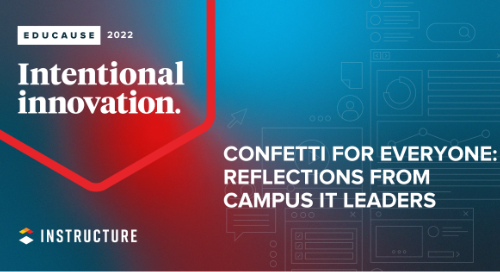This year at Educause, Instructure brought together an off-campus panel of three IT leaders to discuss how their institution is navigating the great re-think in higher ed. The panelists reflected on best practices their campus have honed and how those translate into a future vision of teaching and learning centered around technology driving student success.
The three leaders who shared their unique perspectives were:
-
Jona Burton, Team Leader, Educational Technology Management IT, Kent State University
-
Dr. Scott Vann, Director of Academic Learning Support, University of Memphis
-
Dr. Leslie Kennedy, Assistant Vice Chancellor, Academic Technology Services, California State University
Ryan Lufkin, Vice President of Product Marketing at Instructure, moderated the discussion and offered insights into how the panelists’ experiences mirrored Instructure’s findings in the 2022 State of Student Success and Engagement global trends report.
The panel focused on key areas from the IT leader's perspective including keeping students engaged and on track for successful careers, their Canvas LMS use cases and best practices, and looking to the future.
Prep (for) the Workforce: Student Engagement and Microcredentialing
The conversation around prepping traditional students for the workforce and re-skilling and up-skilling the existing workforce is paramount in higher education today. Each panelist shared how engagement is boosted and supported in their learning environments. In California, “The engagement aspect is a challenge for a lot of faculty not having experience teaching in a digital environment but it is something we worked hard to provide resources and training for,” said Dr. Kennedy. “We are utilizing features in Canvas LMS and supplementing it with other tools such as presentation tools or simulation labs.” Dr. Kennedy also shared that there is a demand for competency-based education and stackable credentials. California community colleges have been moving fast in this direction in particular.
At Kent State, the native features and LTIs in Canvas are key to increasing engagement. “We use tools that were natively integrated with Canvas. Our Kent State Online department put up templates and that has been a real boon to our faculty who are first-time LMS users and helps students to reduce the cognitive load as they go from course to course,” said Burton. Kent also has microcredentialing on their road map and teaches students resume, interviewing, and job skills with tools integrated into Canvas LMS like Microsoft 360.
Corporate Partnerships
Increasingly, institutions are working with corporate partners to provide pathways to jobs and up-skill the existing workforce. The University of Memphis has a flagship program with Fedex designed to reduce the burden of prepaid tuition assistance programs. Prior to this program, less than 8% of the Fedex staff was not using the prepaid tuition assistance program. Now, Fedex staff can take up to nine credit hours a semester from over 120 fully-online global programs at U of M. This initiative has put a spotlight on the university’s development of competency-based microcredentialing programs. Once students graduate, they have a guaranteed promotion opportunity within Fedex. Using an open-enrollment timeline and MasteryPaths within Canvas LMS, students can join courses on their own time and succeed at their own pace.
Favorite Feature in Canvas
-
Blueprint option is a “game changer”
-
Canvas Commons on an institution-only toggle so that resource sharing is made simple
-
Confetti as a positive feedback loop
-
Usability
“When doing our pilot semesters, we launched surveys and the faculty and students replied overwhelmingly that Canvas LMS was ‘just usable’ and this ease of use is the single greatest feature,” Burton said.
What the Future Looks Like
Unanimously, the panel believes purposeful technology and a student-centered, relevant approach are the cornerstones of the future.
“We want to always stay relevant and provide engagement for our students as much as possible,” said Dr. Kennedy in reference to California State University. “Our major themes are enrollment and retention and what we do around technology will be attributed to those issues. The governor's office has asked us to expand our online course offerings at the campus level; focus on professional development and online training with faculty. There’s a lot we are doing to support the future where we are headed.”
At Kent State, “One of our primary focuses is data,” Burton said. “With all the open APIs in Canvas, we are reaching out to stakeholders across campus to understand what types of data they want, what will help predict future trends… exploring what is available and meaningful in the data. We are working to tie learning outcomes in the LMS to accreditation and assessment at the campus level and also looking at corporate connections at the regional level. How can we find collaborations that generate revenue and learners in our system?”
For the U of M, “We are relatively new with Canvas and interested in building out detailed reporting for learning outcomes and continue to grow our continuous education division. Figuring out what the workforce demand is and building out CBE content and journey points is also our future. There is a lot to learn from a Netflix subscription approach to learning and being innovative with our course offering schedules and flexibility.”
Three campus IT leaders, three corners of the country, and one common LMS. One thing was certain, the enthusiasm around the impact of Canvas LMS on their campuses was palpable. Thank you to the panelists for sharing their stories with us while at Educause!
Related Content
 inst-3step.jpg
inst-3step.jpgBlogs
 screenshot_2025-11-21_at_11.46.15_am.png
screenshot_2025-11-21_at_11.46.15_am.pngBlogs
 educause_recap.jpg
educause_recap.jpgBlogs

